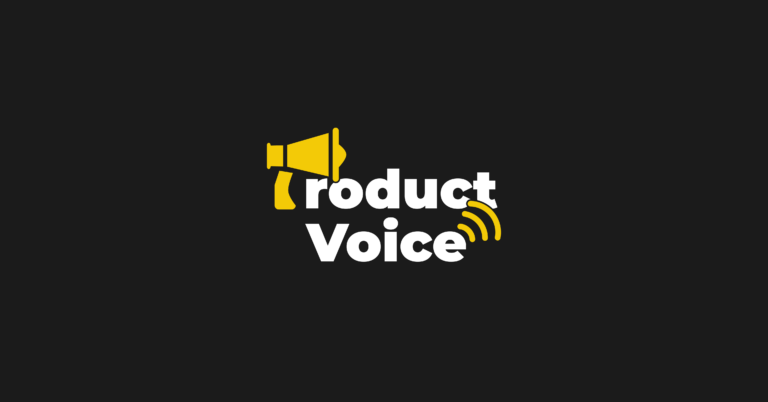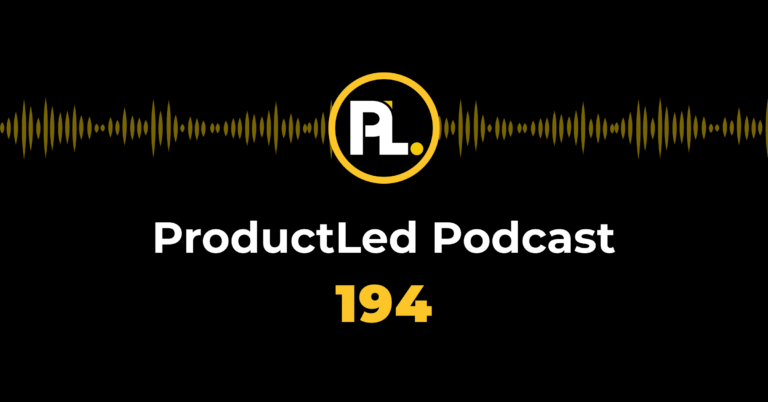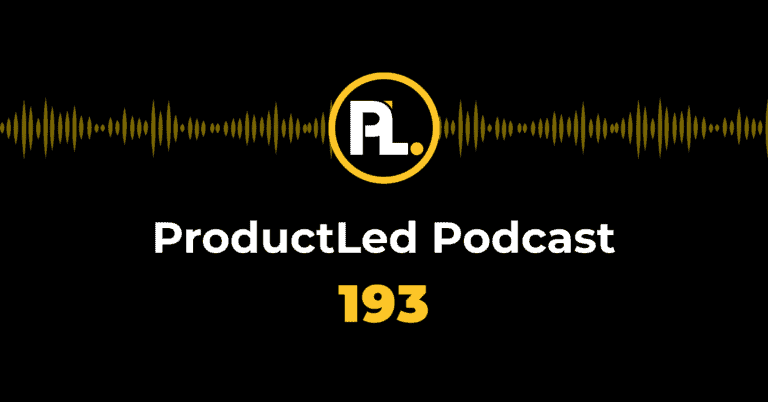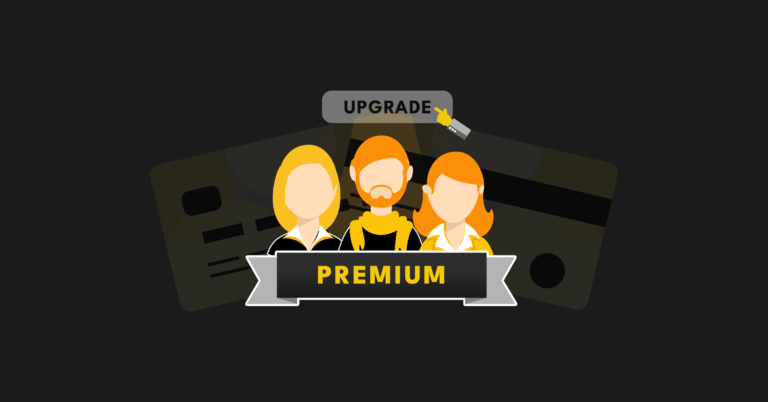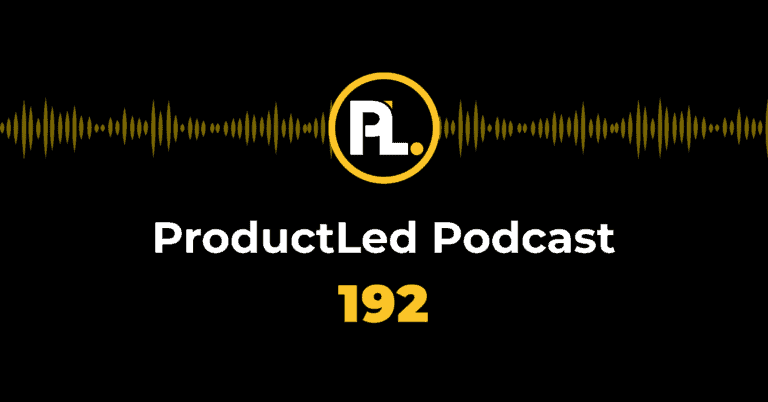Product-led growth is a business strategy that relies on using your product as the main vehicle to acquire, activate, and retain customers. If you’ve used Slack or Dropbox, you’ve witnessed this first-hand. You didn't request a demo to have a salesperson show you how cloud-based file sharing or instant messaging could revolutionize your work. You just tried the product out yourself for free.
Unlike sales-led companies where the whole goal is to take a buyer from Point A to Point B in a sales cycle, product-led companies flip the traditional sales model on its head. Product-led companies make this possible by giving customers a way to experience the product for free, either through a freemium product or some kind of free trial. If the customer experiences a meaningful outcome while using the product, upgrading to a paid plan becomes a no-brainer.
By the end of this article, you'll discover why businesses are opting to be product-led, what it takes to become product-led, and what the main benefits of product-led growth really are.
You can dive into the topic by watching the video below or continuing to read.
Why product-led growth is the future of SaaS
On the surface level, product-led growth (PLG) may look like a simple model for customers to try before they buy.
However, if we look deeper, PLG is a completely new way of growing a SaaS business.
Product-led growth means that every team in your business influences the product. Your marketing team will ask, “how can our product generate a demand flywheel.” Your sales team will ask, “how can we use the product to qualify our prospects for us?.” Your customer success team asks, “how can we create a product that helps customers become successful beyond our dreams?.” By having every team focused on the product, you create a culture that is built around enduring customer value.
Allan Wille, Co-Founder & CEO, Klipfolio
By leading with the product throughout an organization, product-led companies often benefit from:
- Shorter Sales Cycle: By letting users onboard themselves, you can significantly reduce your prospect’s time-to-value and sales cycle. The quicker your users can accomplish a key outcome in your product, the quicker you can convert your free users into paying customers.
- Better User Experience: Since your product is built for people to onboard themselves, people can experience meaningful value in your product without any hand-holding.
- Lower Customer Acquisition Costs (CAC): A self-serve model lowers your cost of acquiring customers by letting users upgrade on their own without interacting with the sales team.
- Higher Revenue Per Employee (RPE): Software was always built to scale well, but with a product-led approach, you’re able to do more with fewer people on your team. Just take a look at Ahrefs in 2019. They have a $40 million ARR business with 40 employees.
Product-led growth isn’t just about disrupting how you sell to distinguish yourself. In today’s market, it’s how you survive. Right now, a tsunami is coming to wipe out thousands of SaaS companies.
Don't have time to read this 4,000+ word guide right now?
No worries. Just click here and we'll send you a PDF of this article so you can read it when it's convenient for you. Just let us know where to send it (takes 5 seconds):
The challenges coming for your SaaS business (& why product-led growth is of rising importance)
Building a profitable SaaS company is tough. There are three reasons why using a product-led growth strategy can sustain and grow your business.
1. Startups are more expensive to grow.
In one sense, this is counterintuitive: It has never been cheaper to build a SaaS company. (HackerNoon even goes so far as to claim that you can now build a SaaS product with $0.)
However, because of this low barrier to entry, there’s no shortage of competition. As a result, it’s becoming more expensive to acquire customers. Just take a look at these channels:
- Google: 108% increase in Cost per Thousand Impressions (CPM) (2021)
- YouTube: 108% CPM (2021)
- Facebook: 89% increase in CPM (2021)
- LinkedIn: 30% increase in CPM (Q4 2021)
There are other channels, of course, but these numbers hint that marketing isn’t getting any cheaper. According to ProfitWell, in the five years prior to 2018, CACs have increased by over 55%.
During that same period, customer willingness to pay for features has dropped by 30%.
So, on one hand, we have rising costs; on the other, we have a lower willingness to pay.
Your expenses go up while your profitability goes down. If you have high churn in your business, this may be lethal.
2. Buyers now prefer to self-educate.
This isn’t limited to the business-to-consumer (B2C) space. Three out of every four Business-to-business (B2B) buyers would rather self-educate and buy through an app than learn about a product from a salesperson, according to Forrester.
By now, I’d like to ask you two questions:
- Would you like to see and use a software product before buying it?
- Or would you prefer to go through a lengthy sales process to see if it’s a good fit?
If you’re like most people, you’ll opt to try out the product on your own. This doesn’t apply just to small and mid-size businesses. As Gainsight notes, “Enterprise buyers also expect to try and evaluate software in an easy, frictionless way.”
Trying out a product through a free trial or freemium model is less hassle and can help a user decide quickly on a product. It’s also easier, which is a high priority for users right now — 89% of consumers said ease is very important or somewhat important when faced with this type of decision, according to Forbes.
3. Your customers have come to expect a frictionless product experience.
The product experience is the customer’s overall experience with the product from trial to paid to renewal. And a majority of today’s customers today don't want to deal with a salesperson when buying software unless they absolutely have to, because it just adds friction to the user’s journey.
If you’ve used Zoom, you’ve witnessed this first-hand—you didn’t need to reach out to a sales rep or book a demo before you were able to try out the service and eventually upgrade to premium. The entire onboarding and upgrade experience was handled by the product.
No need for human intervention. Now, that’s not to say that product-led companies don’t need sales reps. But your product needs to do the heavy lifting when it comes to getting new users up to speed.
These challenges aren’t stopping anytime soon. They’re here to stay. Consumers (like us) demand it. Your SaaS business might be able to weather one of these challenges, but do you really want to take a chance to survive all three?
To put your SaaS business in the best position to win, you need to pick a strategy that will place your business on high ground.
Why the sales-led strategy is at risk
If the only way you can sell a product is if someone talks to you, you’re using a sales-led strategy. Even if you have a marketing engine that generates 1,000s of leads for your sales team, you’re not off the hook.
This is because relying on your sales team to make every sale prevents you from helping your users self-educate. Whether you know it or not, you are adding an incredible amount of friction to the entire product experience. And it keeps your CAC and retention costs high — great sales teams aren’t cheap.
Now, let’s look at the top three problems with this strategy.
1. High customer acquisition costs (CAC).
A big downside of the high-touch sales model is that it contributes to high CAC, and the sales cycles are extremely long.
To make sure the high-touch sales model remains profitable, the lifetime value (LTV) of a customer has to be high enough to recoup the costs of acquiring each new customer. To reach that LTV, most sales-led businesses charge their customers a hefty premium. That premium price isn’t because the solution is more valuable but because the customer acquisition model is more expensive.
As Paul Graham, founder of Y Combinator, states, “The more it costs you to sell something, the more it will cost others to buy it.” In short, a sales-led strategy passes costs to consumers that have no connection to the product value.
If you currently use a sales-led strategy, you need to watch out for competitors with a more efficient customer acquisition model. They can steal your market share by offering a comparable product with a more affordable price tag.
2. The customer acquisition model is leaky.
In a sales-led organization, the customer acquisition model has a big leak. According to SiriusDecisions, 98% of marketing-qualified leads (MQLs) never result in closed business.
One reason this conversion rate is famously awful is that the MQL model has a few hidden flaws:
- It encourages marketers to gate content to hit their MQL goals.
- It focuses on content consumption as a leading indicator of intent.
- The entire process rewards creating friction in the buying process.
As a result, there is often a disconnect between marketing and sales. Should we really be surprised? Does downloading a whitepaper mean you’re ready to buy? Absolutely not.
3. The organizational structure hinders great product development.
According to Elie Khoury, CEO of Woopra, the typical sales-led business structures its team like the image below:

On the left side, you have your profit center, which handles your sales, marketing, and customer success teams. On the right, you have your cost center, which creates the product.
The problem with this organizational structure is that the product is often an afterthought. If the sales team closes a really big customer on the condition of a few product tweaks, well, the engineering and product team have a new project to do.
When your organization leads with sales and follows with the product, you’re forced to move upmarket and get on the elephant-hunting treadmill. And it’s not just my opinion.
| Case Study |
|---|
| “My biggest regret is that our first customer was $1M ACV. Ever since that first customer, our product, go-to-market, our support model have all been pulled in one direction — high-end enterprise. Our first $1M ACV customer forced us to get on the elephant hunting treadmill, and we’ve never been able to get off it. Our board, our employees, everyone expects us to only go after customers that were as large or larger than our first customer. And I’ve been watching this new competitor emerge that’s going after the same market as we are, except from the low end. They are tiny but growing rapidly. And it’s too hard for us to compete with them — we don’t have the people, technology stack, support model or frankly, the mindset." |
This CEO's words reinforced something I have long believed: Truly great SaaS companies are built to be product-led.
How the product-led growth model works
Product-led growth is a life raft that will save you from the flood of rising customer acquisition costs and decreasing willingness to pay for your product.
There’s one key difference between sales-led growth and product-led growth (and no, it’s not just offering a free trial.)
In the typical sales-led growth model, the customer acquisition process has four steps: acquire, monetize, engage, and then expand.
The marketing team brings leads to the sales team, the sales team does whatever it takes to convince prospects to sign a contract, and then a customer success team attempts to deliver on the promises the sales team made. When the customer experiences the value of the product in the engagement step, there may be an opportunity for expansion. But in many cases, the customer never actually experiences the value of the product, leading them to churn.
In a product-led growth model, the engagement step happens before the monetization step.
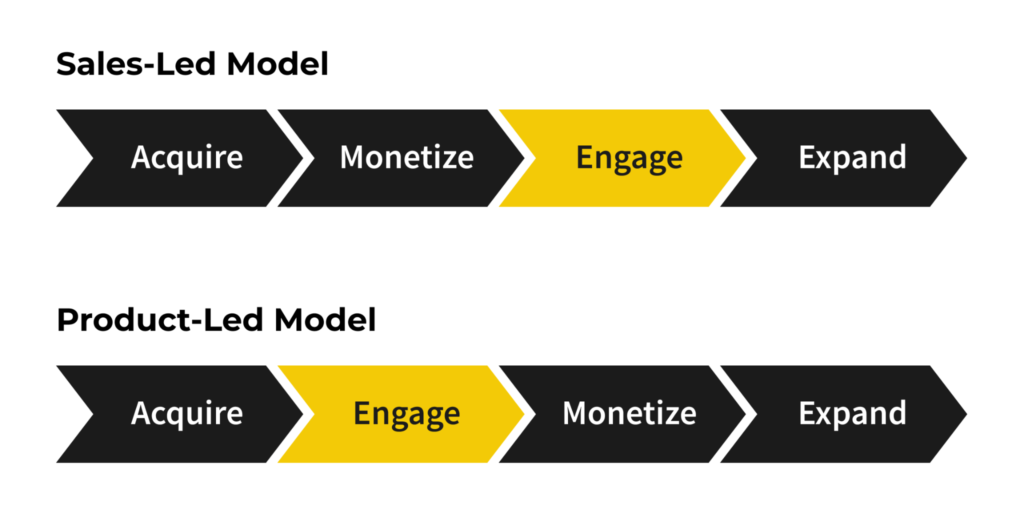
By offering a free trial or a freemium version of your product, you’re allowing customers to engage with your value proposition before you monetize them. In a successful product-led business, monetization is the natural result of engagement because customers are solving a costly pain point with your product and can’t imagine going back to life without it.
Becoming product-led requires a complete culture shift. Instead of prioritizing revenue growth, every department in your software company must prioritize user success, trusting that it will lead to revenue growth.
To create a seamless customer experience across every department, your organizational structure needs to shift so the product team engages with every other department in the business.

What makes a product-led business unique is that all teams leverage the product to hit their goals.
Having the product team involved throughout the business allows for product-led businesses to create a seamless customer experience across every department. What makes a product-led business unique is that all teams leverage the product to hit their goals.
- A product-led marketing team asks, “How can we use our product as the #1 lead magnet?”
- A product-led sales team asks, “How can we use the product to qualify our prospects for us?” That way, we have conversations with people who already understand our value.
- The product-led customer success team asks, “How can we create a product that helps customers become successful without our help?”
- The product-led engineering team asks, “How can we create a product with a quick time-to-value?”
If you can put together a successful product-led growth strategy, you’ll reap some incredible rewards.
The two main benefits of product-led growth
Product-led businesses have an unfair advantage and enjoy access to a dominant growth engine and significantly lower Customer Acquisition Costs (CACs).
1. Dominant growth engine
Product-led businesses tend to scale faster than their competitors in two powerful ways:
- Wider top-of-funnel: A free trial or freemium model opens up your funnel to people earlier in the customer journey. This is powerful because you'll be able to capture the attention of customers long before they are serious about buying. When they do consider paying for a solution, their first thought will be the product they've already had a chance to evaluate, not a product they have to request a demo for.
- Rapid global scale: While your competitors are busy hiring new sales reps for each region under the sun, you can focus on improving your onboarding process to service more customers around the world in a fraction of the time.
2. Significantly lower customer acquisition costs
Using a PLG strategy can result in lower customer acquisition costs for three reasons:
- Sales Team Only Engages with High-Value Deals: Your sales team can focus on higher-value prospects, leaving the product to handle the SMB market on its own. Any time you get a customer to upgrade without interacting with sales, that's going to result in lower CAC than if that same customer had used up a salesperson's time.
- Higher Close Rate for All Sales-Led Deals: Your sales team can focus exclusively on prospects who are likely to upgrade based on their usage of your free product. This is called using Product Qualified Leads (PQLS). A PQL is a lead who has experienced meaningful value using your product through a free trial or freemium model. For example, at Slack, a PQL is an account that has reached its 2,000 message limit. Using PQLs maximizes the sales team’s time because they're only reaching out to the customers who are best positioned for an upsell.
- Less Reliance on Paid Acquisition Channels: A viral freemium product can act as an organic customer acquisition tool and can replace (or supplement) paid acquisition efforts. Instead of buying top spots in search engines or social networks, you can rely on virality and word of mouth to get your product in front of prospects, since people naturally want to share valuable free tools with their network.
The benefits of a product-led GTM strategy don’t stop there. According to OpenView, product-led businesses are valued more than 30% higher than the public-market SaaS Index Fund.
This is one of the main reasons I wrote the book Product-Led Growth: How to Build a Product That Sells Itself.
Implementing a successful product-led strategy is not as simple as giving people the option to try your product before they buy. Your entire approach as an organization needs to shift. Instead of leading with sales and following with product, you need to make sure that every team has a hand in helping each user become successful.
Examples of product-led companies
Despite the risks, countless SaaS businesses, including Grammarly, Slack, and Dropbox, have opted to switch from a sales-led to a product-led strategy to create a moat around their business.
Let’s take a look at some of the most popular product-led companies.
- Calendly: This product solves a near-universal problem and is beloved by 10 million monthly users around the world. Valued at $3B, Calendly helps users schedule and confirm meetings.
- Slack: Founded in 2009, this team collaboration platform boasts over 12 million active daily users, with 156,000 businesses subscribing to the app. In 2021, Slack made $292 million in profit.
- Notion: One of the most flexible productivity software tools, Notion has a $10B valuation.
- Typeform: Built to crunch the data you need to collect, Typeform’s logic jumps are what set this company apart from other survey tools. They recently announced $135 million in Series C funding.
- Wave: Designed to get you paid 3x faster, this free invoicing and accounting software has raised $79.8 million in funding.
- Shopify: Built for entrepreneurs, Shopify makes it incredibly easy to sell online. They had a $1.3B valuation when they filed for an IPO in 2015.
The list goes on and on. Not to mention the list of product-led companies filing for IPOs each year is steadily growing.
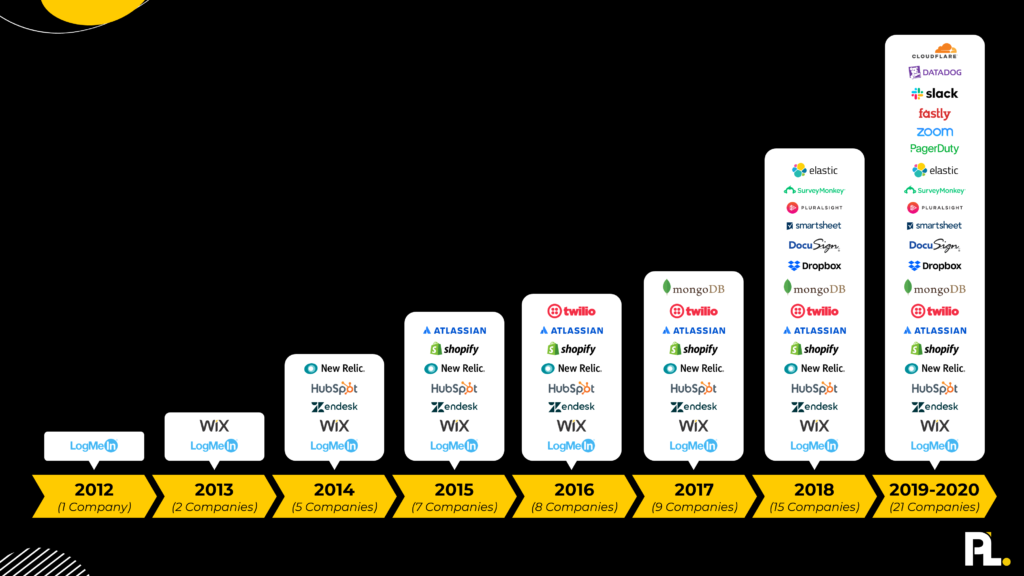
Hubspot’s VP of Marketing, Kieran Flanagan, says the future of growth belongs to product-led companies:
“The future of growth belongs to product-led companies. At HubSpot, we realized this a few years ago, which is why we disrupted our own business model before anyone else could.
– Kieran Flanagan, VP of Marketing, HubSpot
At the time, HubSpot was still growing 30%-40% per year on the shoulders of our original marketing and sales driven inbound marketing model. Despite the success, we consciously chose to upend what had been working by launching our first freemium products.
Market dynamics and consumer behavior have changed - increasingly consumers expect to use software and extract value from it before buying. To stay relevant over the long term we needed to adapt, or risk “getting our lunch eaten.”
Key product-led growth metrics to understand
As we’ve mentioned before, one of the key differences between product-led growth and sales-led growth is the way all teams leverage the product to meet their goals. Instead of each team tracking different success metrics, in a product-led growth model, marketing, sales, customer success, and product management teams all track the same success metrics.
Here are the key product-led growth metrics you should consider tracking when transitioning to a product-led model.
- Acquisition: The number of users who have signed up for your free experience.
- Activation Rate: When the user has experienced meaningful value in the product. (Sometimes referred to as the “Aha!" moment).
- Customer Lifetime Value (CLV): A prediction of how much revenue a single customer will bring in for your business during your relationship.
- Time-to-Value (TTV): The time it takes new users to reach their activation moment. The faster you get users to activate, the more likely it’ll be that they stick around. The main goal of a good onboarding experience is to reduce TTV by as much as possible.
- Free-to-Paid Conversion Rate: The percentage of users that have converted to a paid account from a trial period.
- Expansion Revenue: Expansion revenue is the anti-churn, and one of the most important levers for SaaS growth. Expansion revenue measures the revenue generated from existing customers through upsells, add-ons, cross-sells, etc.
- Net Revenue Churn: This metric measures the amount of money lost after accounting for new and expansion revenue and is often expressed as a percentage.
- Average Revenue Per User (ARPU): This is a great indicator of the overall health of your business. You can calculate this by dividing the Monthly Recurring Revenue by the number of customers.
History tells us that “how” you sell is just as important as “what” you sell. Blockbuster couldn’t compete with Netflix by selling the same digital content. You, too, need to decide: Are you going to be product-led? Or will you risk being disrupted?
Product-led growth FAQs
What is a product-led growth strategy?
In a product-led growth strategy, the product is the primary driver of customer acquisition, engagement, monetization, and retention, instead of a sales team.
In a product-led growth strategy, teams combine their efforts — from sales and marketing to product and customer success. They all align behind the goals and execute a plan in alignment. You can learn how to create a product-led growth strategy here.
What does it mean to be a product-led growth business?
There are some key indicators that a business is product-led: you offer a free model, your user realizes value quickly without talking to a salesperson, your marketing is aimed towards trying the product vs. talking to a sales team, and end-user success is at the front-and-center of your growth strategy.
What is the main difference between sales-led and product-led companies?
If the only way you can sell a product is if someone talks to you, you’re using a sales-led strategy. A product-led company gives the buyer the “keys” to use the product and helps them experience a meaningful outcome while using the product. At this point, upgrading to a paid plan becomes a no-brainer.
How do I choose my product-led model?
When you decide between a free trial, freemium, or demo model, you need to be extremely careful. Unfortunately, you can’t just Google the pros and cons or ask a fellow SaaS founder which business model will work best for you.
To make the right choice, you need a decision framework to decide on whether a free trial, freemium, or demo model will perform best for your business. Read this article to learn the MOAT framework that will help you choose which product-led model is right for your business.
What are the first steps to becoming product-led?
Becoming a product-led company requires a big internal and cultural shift. Every team needs to rally behind the product and end-user success. Assembling a product-led growth team is a good place to start, but you’ll also need to choose the right model, define end-user success, and experiment. If you’re seriously interested in transitioning to become product-led, our coaching program guides product-led founders and their teams through a proven nine-component framework to scale faster and with more control.
Ready to go beyond the basics of product-led growth?
Many SaaS founders need help with product-led growth because they choose free trials simply because competitors do, without considering unique factors. Many take a surface-level approach, offering free trials without building the necessary capabilities. Often, they focus on onboarding when the real issue is their offer.
If these challenges resonate with you and you’re unsure where to focus your efforts, take our free ProductLed assessment. In under five minutes, you’ll receive a personalized 27-page report for your SaaS.
The report includes:
- Phase-wise Recommendations: Start with foundational improvements based on your user profile or product-led model.
- Benchmark Scores: Understand your standing across various components like data, process, pricing, and strategy to identify immediate issues.
- Tips + Resource Recommendations: Get targeted tips and free resources to address specific weaknesses in a strategic order.
Get your free customized report here.
Alternatively, if you’d like to work with a coach to implement a successful product-led approach into your business, check out ProductLed Academy.
Our intensive coaching program helps product-led founders and their teams build a strong foundation for product-led growth so that you can scale faster and with more control.
Learn how our coaching program elevates your product-led growth here.


